

Cheap Solar Cells Offer Hydrogen Hope. Perovskite solar cells have made remarkable progress in the past few years, and the rising efficiency of the low-cost devices has begun to rival conventional silicon cells.
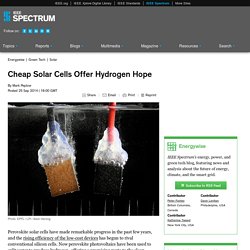
Now perovskite photovoltaics have been used to split water to produce hydrogen, offering a promising route to the clean-burning fuel. Hydrogen is very slowly gaining ground as a transportation fuel, but it has a dirty secret: most of the world’s supply of the gas is made via reactions with methane and steam at high temperatures, releasing the greenhouse gas carbon dioxide in the process. Developing a less-polluting source of hydrogen could help to bolster its green credentials and speed its adoption.
Using electricity from renewable sources to split water by electrolysis, however, is far too expensive today. That’s partly because it takes a voltage of at least 1.23 V to split water, with commercial systems running at about 1.8 V to 2.0 V. Water photolysis at 12.3% efficiency via perovskite photovoltaics and Earth-abundant catalysts. Although sunlight-driven water splitting is a promising route to sustainable hydrogen fuel production, widespread implementation is hampered by the expense of the necessary photovoltaic and photoelectrochemical apparatus.

Here, we describe a highly efficient and low-cost water-splitting cell combining a state-of-the-art solution-processed perovskite tandem solar cell and a bifunctional Earth-abundant catalyst. The catalyst electrode, a NiFe layered double hydroxide, exhibits high activity toward both the oxygen and hydrogen evolution reactions in alkaline electrolyte. Is it time to move away from silicon-based solar? CHICAGO—Currently, the world has the capacity to manufacture over 40 Gigawatts of solar panels each year, the vast majority of them silicon-based.
And it's easy to see why: our expertise with processing the material has led to a staggering drop in costs, making photovoltaics (PVs) much more cost-competitive than just about anyone had predicted. But that manufacturing innovation hasn't been matched on the basic research side; it's been over a decade since the last time anyone set a new efficiency record for silicon cells. And, even as manufacturing costs have dropped, the cost of support equipment and installation has remained stubbornly high and is an ever-increasing slice of the total price of PV systems. That's got people thinking that it might be time that we get more power out of each installation. The material in question is gallium arsenide, which can be fashioned into solar cells with efficiencies twice those of silicon. Gallium goes thin. A Material That Could Make Solar Power “Dirt Cheap” A new type of solar cell, made from a material that is dramatically cheaper to obtain and use than silicon, could generate as much power as today’s commodity solar cells.
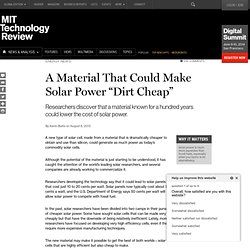
Although the potential of the material is just starting to be understood, it has caught the attention of the world’s leading solar researchers, and several companies are already working to commercialize it. Researchers developing the technology say that it could lead to solar panels that cost just 10 to 20 cents per watt. Solar panels now typically cost about 75 cents a watt, and the U.S. World record solar cell with 44.7% efficiency. The Fraunhofer Institute for Solar Energy Systems ISE, Soitec, CEA-Leti and the Helmholtz Center Berlin jointly announced today having achieved a new world record for the conversion of sunlight into electricity using a new solar cell structure with four solar subcells.
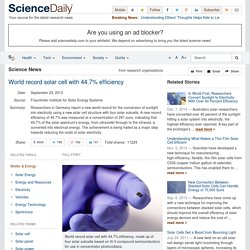
Surpassing competition after only over three years of research, and entering the roadmap at world class level, a new record efficiency of 44.7% was measured at a concentration of 297 suns. This indicates that 44.7% of the solar spectrum's energy, from ultraviolet through to the infrared, is converted into electrical energy. This is a major step towards reducing further the costs of solar electricity and continues to pave the way to the 50% efficiency roadmap. Back in May 2013, the German-French team of Fraunhofer ISE, Soitec, CEA-Leti and the Helmholtz Center Berlin had already announced a solar cell with 43.6% efficiency. Solar panel made with ion cannon is cheap enough to challenge fossil fuels.
Twin Creeks, a solar power startup that emerged from hiding today, has developed a way of creating photovoltaic cells that are half the price of today’s cheapest cells, and thus within reach of challenging the fossil fuel hegemony.
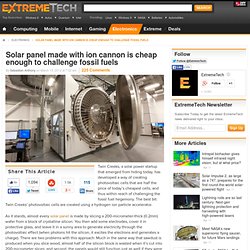
The best bit: Twin Creeks’ photovoltaic cells are created using a hydrogen ion particle accelerator. As it stands, almost every solar panel is made by slicing a 200-micrometer-thick (0.2mm) wafer from a block of crystalline silicon. You then add some electrodes, cover it in protective glass, and leave it in a sunny area to generate electricity through the photovoltaic effect (when photons hit the silicon, it excites the electrons and generates a charge). This is where Twin Creeks’ ion cannon, dubbed Hyperion, comes into play. Japan Has A Plan To Start Using Space-based Solar Power By The 2030s. Solar is Ready Now: 'Ferocious Cost Reductions' Make Solar PV Competitive. By Stephen Lacey "Solar is Ready Now: ‘Ferocious Cost Reductions’ Make Solar PV Competitive" Must-See Photovoltaic Industry Graphs on the Changing Economics of Solar.
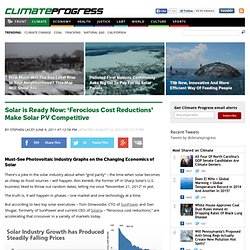
Solar Continued Exponential Growth in 2012, But Politics May Stymie Growth. At any given moment, the sun bathes the earth in enough solar energy to meet its power needs 10,000 times over.
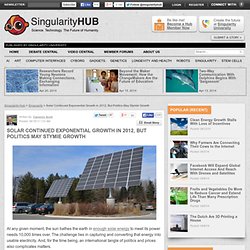
The challenge lies in capturing and converting that energy into usable electricity. And, for the time being, an international tangle of politics and prices also complicates matters. Solar power represents a tiny fraction of the total power used globally, but its use has been growing exponentially in recent years. That trend continued in 2012, according to recently released analyses from the Interstate Renewable Energy Council and Earth Policy Institute. In the United States, solar energy installations increased by 80 percent in 2012, gaining roughly 3.3 gigawatts of capacity. MIT Students Create Solar Panels That Still Work In The Shade. The number of homes with solar panels has grown quickly in the last few years.

But there could be a lot more. Up to three-quarters of houses are still thought to be unsuitable for solar because of shading, ownership, and structural issues. Solar Cell Material Moonlights as Laser. Perovskite is the word of the week!
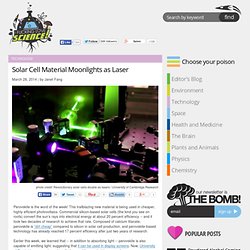
This trailblazing new material is being used in cheaper, highly efficient photovoltaics. Commercial silicon-based solar cells (the kind you see on roofs) convert the sun’s rays into electrical energy at about 20 percent efficiency -- and it took two decades of research to achieve that rate. Composed of calcium titanate, perovskite is “dirt cheap” compared to silicon in solar cell production, and perovskite-based technology has already reached 17 percent efficiency after just two years of research. In the 1960s, scientists figured out that if a material is good at converting light to electricity, then it’ll be good at converting electricity to light.
By sandwiching a thin layer of lead halide perovskite between two mirrors, the team produced an optically driven laser. Turkish Shepherds Use "Plug-and-Play Donkeys" To Get Online. "Fast Company"'s web site claims: The devices, marketed by the Turkish solar panel company Ser-Gün as a "plug-and-play donkey," produce between five and seven kilowatts of electricity, enough to charge many laptops.
That can't be right.